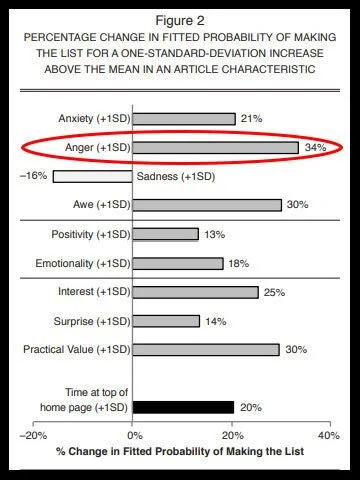Brands Have a Social Responsibility to Create High-Quality Content
Whether it’s an article, image, or video, media wields an enormous amount of power. It has the ability to entertain us, educate us, and inspire us. The written word has brought people together, just as it has torn them apart. A photograph can incite riots as well as encourage reconciliation. Videos can highlight humanity and reveal hatred.
Between social media, digital publications, company websites, and traditional print media, businesses have a wide variety of channels from which to communicate with their audiences. Unfortunately, some brands squander this opportunity by creating clickbait, fake news, misinformation, redundancies, and fear-mongering content because it "gets engagement."
The rat race to the top of Google, the obsession with higher engagement, and the puzzlingly enduring belief that "there is no such thing as bad publicity" encourages companies to focus on quantity over quality. Whether it's the daily onslaught of useless listicles or unproductive social call-outs, it's clear that when clicks equate to dollars, content can go sideways quickly.
Before understanding why brands have a social responsibility to produce high-quality content, we need to break down exactly what “high-quality” means in the context of media. Because, like art, what resonates with one person may repel another.
If you look closely, there are some underlying themes that all high-quality content shares. With this piece, we aim to define those elements, inspire brands to share and create more conscientiously, and consider the social and financial return for crafting valuable, legitimate, truthful material.
The Common Threads of High-Quality Content
Despite the endless range of topics, styles, formats, and mediums, high-quality content has enough commonalities to distill it down to six core elements. For now—and we know this sounds strange coming from a content marketing and SEO agency—forget about word count, keyword density, and backlinks, and ensure your content is always:
1. Contextually Relevant
Sans hate speech, derogatory language, and threats, there are few rules when it comes to the topics brands can discuss. In fact, the traditional guidelines for never talking about sex, religion, and politics can be tossed to the side, as long as it's relevant and you’re an authority in the field. For example, Cosmopolitan has built an empire off of sex advice, Whole Foods has been open about incorporating Buddhist ideals into their mission, and Patagonia never shies away from sharing its anti-corporate, eco-friendly ethos with the world.
Remember, context is critical. While Cosmo can give advice on hot date nights, Whole Foods executives probably shouldn’t provide bedroom tips.
2. Factual & Transparent
You need to be upfront with your audience about whether your content is fact, fiction, or opinion. Furthermore, if you have a site that allows guest contributors, op-eds, and paid endorsements, you need to be transparent about their relationship with your company. That's not just Ethos Copywriting's opinion either; the Federal Trade Commission is cracking down on misleading endorsements and testimonials.
Creating factual and transparent content means you're also crediting your sources appropriately. While most blogs don't require a formal bibliography, you must cite your sources via hyperlinks. Further, it's critical that you find the original source. For instance, if you're reading a Forbes article that cites a statistic from Pew Research, take the extra minute to visit Pew and use their URL as the hyperlink.
As you do your research, ensure your information is coming from trusted publications, such as scholarly journals, books, interviews, etc. In the firestorm of fake news, we also recommend validating the articles you share. If a blog or video seems fishy, err on the side of caution. Should you venture into the political realm, get your facts straight by visiting a few of these resources:
If you can't validate a fact or stat, don't post it. If you still need to share it, make it clear that you were unable to prove a specific figure.
3. Valuable To Your Audience
Brands create value when their audiences are educated and entertained. More specifically, valuable content evokes emotion, solves problems, provides answers, and adds to the greater conversation.
When it comes to branded media, there is no content for content’s sake. Essentially, it’s always about people; give them answers, let them feel something, be their escape, and become their go-to resource.
Ultimately, you want your audience to live better. If they read, watch, or listen to your content and take at least one valuable nugget away from it, you’ve done your job.
4. Grammatically and Syntactically Sound
Grammatical and syntactical errors happen to the best of us. It's for this reason that Ethos runs every piece by our editors before publication. Typos aren't a deal-breaker for your audience, but they are certainly distracting. If errors become a regular occurrence, you'll risk damaging your credibility.
Safeguard yourself by hiring a writer and editor to help you produce better content. If you're still writing without a safety net, here are a handful of the most common errors we see:
Comma splice (e.g., Hemingway was an incredible writer, he began writing as a kid)
Malaprops (e.g., precede/proceed, muster/mustard, monotony/monogamy)
Punctuation problems (unnecessary ellipses and quotation marks, possession problems)
Unclear antecedents (Unclear what “this” is)
Word confusion (e.g., then/than, lose/loose, their/there/they’re)
Word mirrors (the same phrase used in a string of sentences)
While our next point has less to do with grammar and syntax, it's vital to consider the connotations of the words you use. Moreover, as technology and society changes, so does language. Here are a couple of examples:
Positive Versus Negative Connotation:
Experienced vs. Old
Youthful vs. Childish
Utilize vs. Exploit
Words With New Meanings:
Block
Catfish
Cloud
Ping
Sandbox
Text
Unplug
Viral
5. Actionable
Avoid the hard sell. In an age where we're exposed to ads all day, a little something for nothing builds trust in a brand. With that said, your audience should have a sense of direction at the end of your piece, be it a blog, video, podcast, etc. Let them know where to go to read, watch, and listen more. Tell them how to get more information about your products and services.
Good Example:
[Comprehensive blog post here] + If you need help building your digital presence, click the button below to learn how we can help develop content that reaches and resonates with your audience.
Bad Example:
[Low-value blog post here] + Click the Button Below to Buy Now!!!
From our social feeds to our TV screens, there aren’t many places we can go to get away from intrusive advertising. Give your audience a break by giving them content they can sink their teeth into.
6. Socially Responsible
While all of the above rules are critical, this last core principle was the inception of this blog. Why? Because there is an obsession with going viral. Ad click revenue models are encouraging businesses to aim for the absurd instead of the authentic, evoke anger instead of understanding, and spread fear instead of inspiration.
This guideline is not to say that you shouldn't produce content that revolves around worrisome and intense events, opinions, and predictions. People should be informed.
The problem is that brands can “game” the system to reach a wider audience. To understand how brands can manipulate engagement, you need to understand the overarching goals of viral content. By and large, frequently-shared and engaging content aims to:
Anger (Fire someone up)
Connect (Highlight relatable subjects)
Educate (Teach people something interesting)
Entertain (Make people laugh)
Humanize (Show relatable vulnerabilities)
Inspire (Show people hope)
The first item on the list is the one that brands should be careful with. Rage is like jet fuel for engagement. In fact, a study published by the Journal of Marketing Research shows that people are more likely to share anger-evoking content on social media than any other kind of content. The problem is that using rage to generate engagement is like juggling torches over a barrel of gasoline.
We've all seen social media brawls, the emergence of call-out culture, actionless posts that point out problems without providing any sense of a solution. Don't get us wrong, drama can make good stories more interesting, and it definitely helps keep the eyeballs on you. Prime example: Trump had more than double the amount of screen time on the nightly news than any other candidate in the 2016 election.
In essence, he turned an election into nightly entertainment and capitalized on the virality of anger and fear. Many political scientists believe this media time was a driving factor in his election success. However, the societal repercussions of subscribing to this strategy can quickly outweigh the benefits. Regardless of your political affiliation, it's clear that there was never an election that caused as much polarization and turmoil as the 2016 race.
The ramifications of the past election even provoked volatile family feuds. A 2019 survey by The Atlantic showed that "35 percent of Republicans and 45 percent of Democrats said they would be unhappy if their child married someone of the opposing political party—a sharp increase from attitudes 50 years ago."
During tumultuous times, both those consuming and producing content must learn from previous blunders. It's how, as a society, we right the ship. More specifically, it's how we learn to consume and create content more responsibility.
Believe it or not, there is a balance to this social upheaval. As Economist, Joseph Schumpeter wrote in Capitalism, Socialism, and Democracy:
The opening up of new markets, foreign or domestic, and the organizational development from the craft shop to such concerns as U.S. Steel illustrate the same process of industrial mutation—if I may use that biological term—that incessantly revolutionizes the economic structure from within, incessantly destroying the old one, incessantly creating a new one. This process of Creative Destruction is the essential fact about capitalism.
To put it another way—and as the Red Hot Chili Peppers once sang, "Destruction leads to a very rough road, but it also breeds creation." For this reason, brands should not necessarily shy away from content that may evoke anger or fear. However, the intent of that media must be to add value and inform audiences, and not merely to "go viral."
Purpose & Social Responsibility
In essence, social responsibility is the obligation to:
Act in the best interest of society
Be transparent
Conduct business lawfully
Contribute to sustainable development
Fulfill civic duties
In today's tumultuous economic, political, and social climate, people are increasingly looking at companies to be a force for positive change. Consumers want to do business with brands that share similar values and have a social mission. According to Cone Communications, "Communicating strong corporate social responsibility consistently reaps reputational and bottom-line benefits year-over-year." Researchers at Cone also found that:
63% of Americans are putting their faith in companies to ignite change
87% said that they’d purchase a product if the company advocated for an issue they cared about
87% will also share their positive opinions about companies doing good
89% said, given the same price and quality, they’d switch brands if said brands were associated with a good cause
More specifically, consumers want companies to address issues such as:
Climate change
Cost of higher education
Domestic job growth
Economic development
Gun control
Immigration
LGBTQ rights
Poverty and hunger
Racial equality
Women’s rights
You Don’t Have to Be Perfect to Have a Purpose
So you've made some mistakes in the past, that's okay. It's never too late to change your business practices and start producing content with a purpose. 91% of Americans say it's okay if a company isn't perfect, as long as they're honest about their efforts. Secondly, making a mistake is an ideal opportunity to share your journey with your audience and talk about what you learned.
The Business Perks of Providing High-Quality Content
When people align with a brand, the brand's content can actually become part of their identity. In a study published by the New York Times, 68% of people who share content reported that they did so to give other people a better sense of who they are and what they care about.
This kind of word of mouth (WOM) is invaluable to brands. In the case of increasing conversions, McKinsey found that WOM is the primary factor behind 20 to 50 percent of all purchasing decisions. Their research also showed that “a high-impact recommendation—from a trusted friend conveying a relevant message, for example—is up to 50 times more likely to trigger a purchase than is a low-impact recommendation.”
Although purchases are the end-goal for most businesses, writing high-quality content has a multitude of other benefits such as:
Better consumer relationships
Financial savings from foregoing paid search
Higher-quality lead generation
Increased traffic
Higher search ranking
Higher revenue
Improved brand awareness
More authority
Find Your Ethos
We want to make it clear that not all of your content needs to be purpose-driven. However, all of your content should be high-quality.
Make people laugh, inspire them, and connect with them. What is important is that bad news doesn’t get manipulated into clickbait. Yes, anger and fear spread quickly through social channels, but the data that substantiates this fact is also perpetuating it. In other words, because brands think producing actionless, anger-evoking content is the only way to get in front of their audiences, they continue to create more of it.
Ethos is confident that if brands make it their responsibility to share and create high-quality content, audiences will engage with it. As people engage with your work, their personal social algorithms will start to present them with less fear-mongering clickbait and more truthful media.
If you need help developing content that resonates with your audience, reach out to Ethos Copywriting to learn more about our process. Just here for a good read? Please show your support by liking and sharing this piece, and let us know your thoughts below. As always, thank you for reading.







